The X Button
Terms of Robot Warfare
by Todd Ciolek,

I always find some reflexive joy in the announcement of any new Final Fantasy character, not so much because I'm still hopelessly fond of the series (though I am), but because new Final Fantasy characters were the first interesting things I ever saw online.
Throughout most of the 1990s, I was denied the Internet by my well-meaning parents, who were convinced that the Apple IIGS was the only computer they and their children could ever need. It was at school that I first ventured onto what people insistently called the world wide web. At the first moment the teacher wasn't making us check news pages or set up e-mail accounts, I shot off to Gamefan's website (which, like the magazine that spawned it, is long dead), and the first images I spied there were shots of the vampire guy and the lion-thing from Final Fantasy VII. Yes, they have names, but no one knew them at that point.

That's why I was excited about Sazh Katzroy (pictured above) becoming the latest Final Fantasy XIII character. A military veteran and acquaintance of heroine Lightning, Sazh is joined by a baby Chocobo that supposedly lives in his hair. While he's the first Tetsuya Nomura design in a long time that isn't covered in belts and beads and sashes and jorts and lederhosen, Sazh perhaps also embodies some of the visual stereotypes that Japan still insists on applying to black characters. Then again, it's an improvement on Final Fantasy VII's Barret, who swore constantly and vented his rage by randomly firing a gun grafted to his forearm. Final Fantasy XIII's script will likely treat Sazh better than that, though it'll be many months before we find out for certain.
In fact, Final Fantasy XIII seems a long way off, even with a demo arriving alongside the Japanese Advent Children Blu-Ray release in April. We've seen only five of the newest Final Fantasy's cast so far (counting the baby Chocobo as a character) and we won't see the game in the U.S. until 2010. But I don't mind as long as I can get irrationally nostalgic about every little piece of it.
NEWS
NEW SUPER ROBOT WARS TO HIT DS
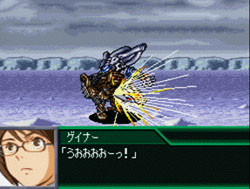 Yes, it's another new Super Robot Wars game, this time with a K! It's also going to be the first title in the series built from scratch for the DS, which could mean all-new models for the mecha involved. But no one cares about that, at least not one-tenth as much as they care about the robots included. Super Robot Wars K will reportedly feature the lead robots from Gundam SEED Destiny, Gundam SEED, that Gundam SEED Stargazer thing, Fafner, Gaiking, Kotetsushin Jeeg, Gun X Sword, Virtual On Marz (a.k.a. the Virtual On that no one liked), Dangaioh, Mazinger Z, Zoids Genesis, both seasons of Godannar, and Overman King Gainer. I'm glad to see Gainer, if only for the implied promise of hearing its theme song come from a DS. I was glad to see Dangaioh for the same reasons, but then I remembered that KMFDM's “Ultra” is not Dangaioh's theme song and is, in fact, some unrelated music which Manga Video once used in a trailer featuring Dangaioh.
Yes, it's another new Super Robot Wars game, this time with a K! It's also going to be the first title in the series built from scratch for the DS, which could mean all-new models for the mecha involved. But no one cares about that, at least not one-tenth as much as they care about the robots included. Super Robot Wars K will reportedly feature the lead robots from Gundam SEED Destiny, Gundam SEED, that Gundam SEED Stargazer thing, Fafner, Gaiking, Kotetsushin Jeeg, Gun X Sword, Virtual On Marz (a.k.a. the Virtual On that no one liked), Dangaioh, Mazinger Z, Zoids Genesis, both seasons of Godannar, and Overman King Gainer. I'm glad to see Gainer, if only for the implied promise of hearing its theme song come from a DS. I was glad to see Dangaioh for the same reasons, but then I remembered that KMFDM's “Ultra” is not Dangaioh's theme song and is, in fact, some unrelated music which Manga Video once used in a trailer featuring Dangaioh.
If you find yourself missing The Big O, the Nirvash, and all of the older Gundam mobile suits that apparently won't be in SRW K, you can import the Super Robot Wars Z Special Disc for the PlayStation 2 in March. It features some new scenarios and a few new robots in a lineup already full of familiar mecha, including…Overman King Gainer? Funny how that works out.
BANDAI TURNS .HACK//LINK MANGA INTO GAME
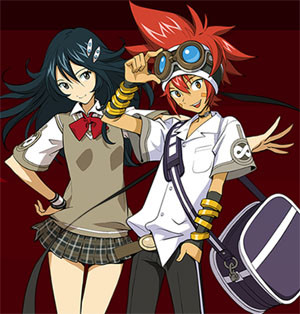 I'm not surprised that Bandai and CyberConnect2 are making a new .hack game. I'm surprised that .hack//Link is only a PSP title and a manga by Megane Kikuya so far. Each new game in the .hack series is normally accompanied by an anime production that connects to its video-game source in various ways, so I'll just assume that some anime studio is already hard at work on a new series called .hack//BALLWASH or something.
I'm not surprised that Bandai and CyberConnect2 are making a new .hack game. I'm surprised that .hack//Link is only a PSP title and a manga by Megane Kikuya so far. Each new game in the .hack series is normally accompanied by an anime production that connects to its video-game source in various ways, so I'll just assume that some anime studio is already hard at work on a new series called .hack//BALLWASH or something.
If .hack//Link has anything in common with the manga of the same name, it's set three years after the end of .hack//G.U., in an age when The World: RX has emerged as the latest hot online game for all civilization. The kid with the Chrono Trigger hairstyle is Tokio, a game geek who's desperate to get into the newest version of The World and finds his wish granted by Saika, the raven-haired transfer student next to him. Using some bizarre technology, Saika transports herself and Tokio into The World, not as game avatars but as flesh-and-blood participants. This, of course, Should Be Impossible, and a few battles rapidly put the two players in contact with a bunch of familiar .hack protagonists, or at least characters who look like the leads of .hack//SIGN and .hack//G.U. It's hard to tell with .hack.
DRAGON BALL MOVIE GETS DRAGON BALL GAME...I THINK
You know, I'm not going to offer any critical commentary on these shots from Namco Bandai's Dragon Ball: Evolution (or Dragon Ball: The Movie: The Game) for the PSP. I'm just going to present the facts about it so we can all get through this with some dignity intact.
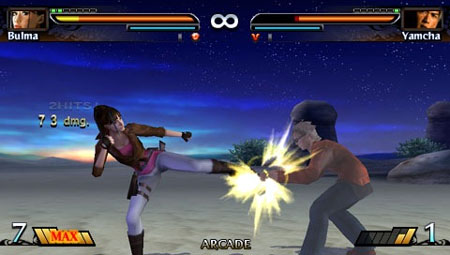
Dragon Ball Evolution is based on the upcoming movie starring Justin Chatwin, James Marsters, and Chow Yun-Fat.
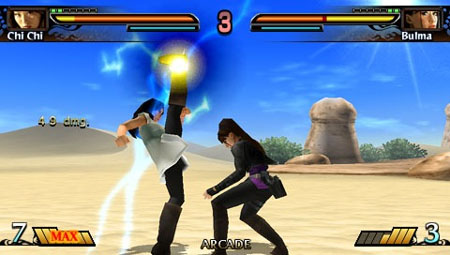
Dragon Ball: Evolution features a story mode, a mission mode, and an online versus mode.
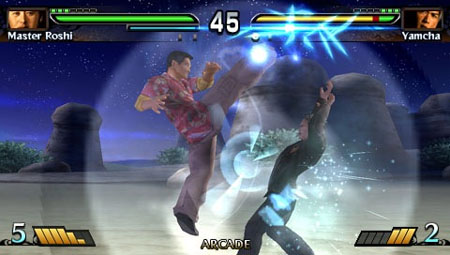
Dragon Ball: Evolution will probably not crawl out of its case at night, slide into your trachea, and choke you to death in your sleep if you happen to buy it.
AND NOW I MUST TALK ABOUT M.U.S.H.A.
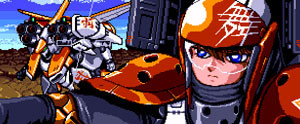 The Wii's Virtual Console still comes under fire for its scarce updates, but I'm quite pleased with the service's Sega Genesis library as it stands now. It has Gunstar Heroes, it has Phantasy Star IV, and, as of this Monday, it has M.U.S.H.A. That's all the Genesis catalog I need to be happy, though I wouldn't mind El Viento or Alisia Dragoon.
The Wii's Virtual Console still comes under fire for its scarce updates, but I'm quite pleased with the service's Sega Genesis library as it stands now. It has Gunstar Heroes, it has Phantasy Star IV, and, as of this Monday, it has M.U.S.H.A. That's all the Genesis catalog I need to be happy, though I wouldn't mind El Viento or Alisia Dragoon.
By my estimate, several hundred thousand shooters were released on the Genesis, and Compile's M.U.S.H.A. is the best of them. It expertly meets every possible demand of a 2-D vertical shoot-'em-up: amazing visual detail, frequent and useful weapons, devious level layouts, and a pounding, memorable soundtrack. The stages are long, tenacious challenges, and there's no rigidly chosen method for surviving them, as the M.U.S.H.A. Aleste fighter has two roving pods to use in all sorts of offensive or defensive stratagems. The game even has a pretty, pre-credits story that fires up one pilot's desperate battle and then stays out of the way until the ending.
Seismic's original release of M.U.S.H.A. is fairly expensive on the collectors' market, so it's all the more appealing to go for the eight-dollar Virtual Console version. The only thing you'll lack is an instruction manual that refers to the Aleste's pilot, Terri, as “the heroin of this adventure.”
SPECIAL FEATURE: REMAKE ROUNDUP
True artists are never satisfied with their creations, some might say. Others, possessed by more jaundiced frames of mind, might say that publishers are never satisfied with reaping profits from just one version of a game. Either way, there's rampant fondness for remakes, reissues, and ports in the modern Japanese game industry, whether the resurrections involve a cult-favorite Game Boy RPG or the best-adjusted female character in Evangelion spin-off history.
SAGA 2
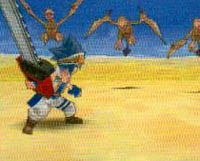 Many expected Square's next DS remake to come from the Final Fantasy series, perhaps as V or VI. Few pegged Square's Game Boy RPG Saga 2: Treasure Legend, known here as Final Fantasy Legend II, as the most likely candidate to be rebuilt with 3-D visuals and voice acting. In line with the Final Fantasy III and IV DS revamps, the new Saga 2 will have large-headed characters and colorful environments, with artwork by Gen Kobayashi, last seen helping Tetsuya Nomura with the character design in The World Ends With You.
Many expected Square's next DS remake to come from the Final Fantasy series, perhaps as V or VI. Few pegged Square's Game Boy RPG Saga 2: Treasure Legend, known here as Final Fantasy Legend II, as the most likely candidate to be rebuilt with 3-D visuals and voice acting. In line with the Final Fantasy III and IV DS revamps, the new Saga 2 will have large-headed characters and colorful environments, with artwork by Gen Kobayashi, last seen helping Tetsuya Nomura with the character design in The World Ends With You.
The Saga series began as an experimental lab for producer Akitoshi Kawazu, and Saga 2 disrupts a few RPG traditions. For one thing, it abandons the semi-grounded setting of a Final Fantasy or Dragon Quest in favor of a story that skips from one world to another, setting down in a land of Greek myths for one quest and then plunging into a human body to fight off infectious monsters. Character growth takes a similar journey: humans and mutants gain levels by picking particular stat boosts, while robots and monsters do it by scavenging enemies' corpses for new parts and comestibles. Nor does Saga 2 bother with keeping things on a medieval-fantasy level; characters can use lightsabers, chainsaws, guns, and anything else that fits into the game's selection of worlds. It remains to be seen if Square will punch up the half-there storyline or re-work the combat, but Saga 2 already has a healthy following in Japan.
NITRO+ ROYALE
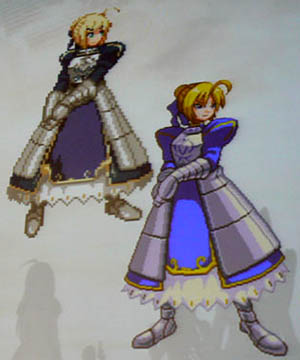 As a noted developer of many Japan-only PC “visual novels,” Nitroplus (a.k.a. Nitro+) is hardly a familiar name to the typical North American anime fan, though a few of their works have inched over here. The company helped create Gonzo and Ichiro Itano's GC-heavy German superhero series Blassreiter, and Nitroplus games were the basis for the Demonbane and Chaos; Head anime. Even Phantom of Inferno, Nitroplus' first hit, saw an English release in both game and OAV form courtesy of Media Blasters and the now-defunct Hirameki International.
As a noted developer of many Japan-only PC “visual novels,” Nitroplus (a.k.a. Nitro+) is hardly a familiar name to the typical North American anime fan, though a few of their works have inched over here. The company helped create Gonzo and Ichiro Itano's GC-heavy German superhero series Blassreiter, and Nitroplus games were the basis for the Demonbane and Chaos; Head anime. Even Phantom of Inferno, Nitroplus' first hit, saw an English release in both game and OAV form courtesy of Media Blasters and the now-defunct Hirameki International.
In other words, Nitroplus has plenty of games featuring anime girls of all shapes and nerd fetishes, and Nitroplus decided to put the most popular of them in a PC fighting game called Nitro+ Royale: Heroines Duel. It was, to be terse, the sort of fighter you'd expect from a company that previously made only dialogue-based adventure games. The visuals look like a stiff Super NES fighter, and everyone seems to agree that the gameplay is unbalanced and unimpressive. It is, however, full of Nitroplus characters, including Phantom's Ein and Jingai Makyo's Ignis (who fans of expensive import figures might recognize), plus a cameo by Saber from Type-Moon's Fate/stay Night.
As for the game's remake, all is not lost: Milestone Inc., developer of shooters like Chaos Field and Radilgy, is re-working Nitro+ Royale for an arcade release on Sega's Naomi board by using new, hi-res character sprites (left). It'll arrive later this year in Japanese arcades, where it will die a swift and ugly death if its mechanics aren't up to competitive standards.
NEON GENESIS EVANGELION: IRON MAIDEN
Neon Genesis Evangelion games come out all the time in Japan, but Iron Maiden (or Girlfriend of Steel) has a notable place in the series. While it's a conversation-driven “adventure” title from 1998, it's among the most elaborately faithful Evangelion games, as it was dressed up to look like a lost episode of the TV series. It's up to fans to decide whether or not its story is fit for Evangelion canon, since Iron Maiden involves a new transfer student named Mana Kirishima arriving at Shinji's school just to become his surprisingly stable girlfriend. Of course, she has a tragic secret, and, of course, there's a heap of angst to be vented by all concerned.
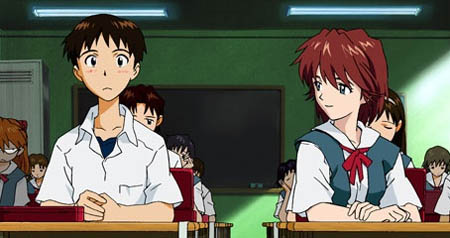
Having appeared on the Saturn, PlayStation, PC, and PlayStation 2, Iron Maiden is now showing up on the PSP this April. There's no sign of radically new content, but it's an interesting re-release in light of everyone speculating about the identity of a new female character in Evangelion 2.0: You Can (Not) Advance. It's true that Mayumi Yamagishi, a bespectacled girl introduced in the game Evangelion: 2nd Impression, would fit the bill more than Mana, though one must wonder why Mana's game is the one to get a PSP port.
RELEASES FOR THE WEEK OF 1-25
AFRO SAMURAI
|
|
DJ MAX FEVER (Pentavision/Navarre, PSP, $29.99)  DJ Max Fever recalls a time, just under ten years ago, when countless electronica/house/fusion/acid/trip-hop DJs were putting crude anime-girl simulacra on their album covers and posters. In this decade, that trend gave way to rhythm games that use professional anime-style illustrations, and DJ Max Fever fits right into that field. Fever's actually a combination of two Korean-made music games: DJ Max Portable and DJ Max 2. While its genre was recently overrun by musical-instrument controllers, DJ Max hearkens back to the Parappa school, where players tap buttons to keep pace with the rapid pulse of various mixes. The on-screen interface is similar to Beatmania's (minus the turntable), with sounds represented by colored bars that fall down to a line. Each level of difficulty employs a different number of keys, and the game rewards those who achieve that near-psychic mastery of matching beats within milliseconds. DJ Max Fever recalls a time, just under ten years ago, when countless electronica/house/fusion/acid/trip-hop DJs were putting crude anime-girl simulacra on their album covers and posters. In this decade, that trend gave way to rhythm games that use professional anime-style illustrations, and DJ Max Fever fits right into that field. Fever's actually a combination of two Korean-made music games: DJ Max Portable and DJ Max 2. While its genre was recently overrun by musical-instrument controllers, DJ Max hearkens back to the Parappa school, where players tap buttons to keep pace with the rapid pulse of various mixes. The on-screen interface is similar to Beatmania's (minus the turntable), with sounds represented by colored bars that fall down to a line. Each level of difficulty employs a different number of keys, and the game rewards those who achieve that near-psychic mastery of matching beats within milliseconds. Get Excited If: You own Pop'n Music Disney Tunes and refuse to be embarrassed about it.
|
|
NOBUNAGA'S AMBITION: IRON TRIANGLE (Koei, PS2, $29.99) 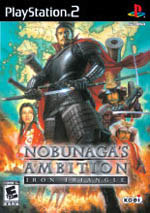 I can't look at a single Nobunaga's Ambition game without remembering that I pronounced it “Nowabunga” back in the days of the NES, as though it were named after a Ninja Turtles catchphrase. Twenty years later, the series still has the same goal: capturing the rise of warlord Oda Nobunaga in strategic gameplay that spans both battle tactics and routine economic matters. Iron Triangle's 3-D map is new to the series, though I imagine returning fans will care more about the options beneath the workmanlike graphics. Nobunaga gets over 100 castles and towns to micro-manage across feudal Japan, plus about 1000 lords to either recruit or overrun. Battles can take place on land or sea, and there's an ever-growing peasant class to be placated, lest they rise up and bring about Nobunaga's historically inaccurate demise. I can't look at a single Nobunaga's Ambition game without remembering that I pronounced it “Nowabunga” back in the days of the NES, as though it were named after a Ninja Turtles catchphrase. Twenty years later, the series still has the same goal: capturing the rise of warlord Oda Nobunaga in strategic gameplay that spans both battle tactics and routine economic matters. Iron Triangle's 3-D map is new to the series, though I imagine returning fans will care more about the options beneath the workmanlike graphics. Nobunaga gets over 100 castles and towns to micro-manage across feudal Japan, plus about 1000 lords to either recruit or overrun. Battles can take place on land or sea, and there's an ever-growing peasant class to be placated, lest they rise up and bring about Nobunaga's historically inaccurate demise. Get Excited If: You're sick of games and anime that make Nobunaga out to be a hideous demon king. ALSO THIS WEEK: |
EXTRA LIVES: RANMA ½ II: ANYTHING-GOES MARTIAL ARTS
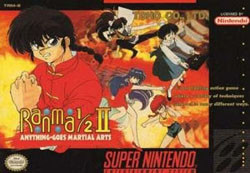 You kids today, with your fancy Huluroll websites streaming all sorts of anime TV shows from Galaxy Express 999 to Eve no Jikan. You have no idea what it was like back in the mid-1990s, when few anime publishers in North America would dare to put out lengthy anime TV series. The one towering exception to this was, of course, Ranma ½. Ranks of the show's two-episode VHS releases dominated cramped anime sections in video stores everywhere, and people willingly paid $30 for each of those tapes. Naturally, someone decided to bring over Ranma ½ video games, with a series of Super Famicom fighters being the most obvious choices.
You kids today, with your fancy Huluroll websites streaming all sorts of anime TV shows from Galaxy Express 999 to Eve no Jikan. You have no idea what it was like back in the mid-1990s, when few anime publishers in North America would dare to put out lengthy anime TV series. The one towering exception to this was, of course, Ranma ½. Ranks of the show's two-episode VHS releases dominated cramped anime sections in video stores everywhere, and people willingly paid $30 for each of those tapes. Naturally, someone decided to bring over Ranma ½ video games, with a series of Super Famicom fighters being the most obvious choices.
Unlike the anime and manga, the Ranma ½ fighters had a rough journey westward. Irem mangled the first one, completely overhauling its graphics and ditching the license to bring American Super NES owners Street Combat, a Street Fighter II clone that everyone hated. As if in apology, the second fighter arrived here unmolested as Ranma ½: Hard Battle, and for a moment fans of the anime thought they had won. Then the third fighter, Ranma ½ II: Anything-Goes Martial Arts, was canceled at the eleventh hour, with its official box art (above) and magazine ads taunting half a generation of anime fans.
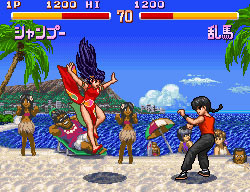 Many of those fans refused to admit defeat and imported the game, known as Ranma ½: Chougi Rambu Hen in Japan. To the chagrin of some and the relief of others, it had no real storyline to translate, beyond a bunch of Ranma ½ regulars gathering to fight over a lucky cat statue that grants wishes and, presumably, could dispel the curses that cause most of the characters to turn into cats and pigs and redheaded girls. The lineup is well-stocked for a 1994 fighter, drawing in Ryoga, Akane, Kuno, panda-form Genma, Ukyo, Shampoo, Mousse, Kodachi, and both the male and female versions of Ranma. Curiously, the game loses a few characters from the previous Ranma ½ fighter (Happosai, King, Gosunkugi, and Pantyhose Taro), replacing them with cheerleader martial-artist Mariko, the bratty Hinako, and the manga-exclusive villain Herb.
Many of those fans refused to admit defeat and imported the game, known as Ranma ½: Chougi Rambu Hen in Japan. To the chagrin of some and the relief of others, it had no real storyline to translate, beyond a bunch of Ranma ½ regulars gathering to fight over a lucky cat statue that grants wishes and, presumably, could dispel the curses that cause most of the characters to turn into cats and pigs and redheaded girls. The lineup is well-stocked for a 1994 fighter, drawing in Ryoga, Akane, Kuno, panda-form Genma, Ukyo, Shampoo, Mousse, Kodachi, and both the male and female versions of Ranma. Curiously, the game loses a few characters from the previous Ranma ½ fighter (Happosai, King, Gosunkugi, and Pantyhose Taro), replacing them with cheerleader martial-artist Mariko, the bratty Hinako, and the manga-exclusive villain Herb.
The first Ranma ½ fighter is a simple, shallow thing with barely any special moves, which made it no real loss when Irem butchered it. The second one uses basic combos and a strange, press-and-release special-move technique that only the subsequent Primal Rage was dumb enough to imitate. Fortunately, Rumic Soft gave Ranma ½ II: Anything Goes Martial Arts a tighter game engine and traditional super moves that were familiar ground to anyone who tried Street Fighter II more than twice.
If Anything-Goes Martial Arts has solid play mechanics, it seldom broadens them. It's a basic 1994 fighting game, with slow jumping, a limit of three or four moves per character, and a rudimentary combo system. The game also does little with the characters' shape-shifting, as only Hinako can change form. The few interesting ideas show up in activating super moves. Hold the taunt button and your life meter starts glowing, allowing you to launch a super just as long as your opponent doesn't hit you first. There's also a tag mode where players can switch between two characters during battle, and Capcom totally stole that idea for its Versus series of fighters. Everything starts with anime, after all.
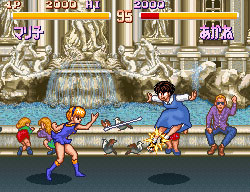 Anything-Goes Martial Arts looks a bit primitive by the standards of Capcom or SNK's mid-'90s fighting series, but it still carries some of Ranma ½'s cartoon charms. Anime fans would likely revel in Ryoga's descending tanuki-statue attack or a mid-air Genma's flailing panda arms. The backdrops also show some decent range, including Rome's Trevi Fountain, Loch Ness, the Taj Mahal, and, uh, a Hawaiian beach. The voice samples are muted but apparently provided by the Ranma ½ anime actors, while the soundtrack is unmemorable fighting-game boilerplate music.
Anything-Goes Martial Arts looks a bit primitive by the standards of Capcom or SNK's mid-'90s fighting series, but it still carries some of Ranma ½'s cartoon charms. Anime fans would likely revel in Ryoga's descending tanuki-statue attack or a mid-air Genma's flailing panda arms. The backdrops also show some decent range, including Rome's Trevi Fountain, Loch Ness, the Taj Mahal, and, uh, a Hawaiian beach. The voice samples are muted but apparently provided by the Ranma ½ anime actors, while the soundtrack is unmemorable fighting-game boilerplate music.
There's little doubt that the English release of Ranma ½ II: Anything-Goes Martial Arts would have delighted Ranma ½ fans and perhaps pleased a few critics back in 1994, but it missed out. Today, it's just another competent 16-bit fighter with little to offer the enthusiast subculture or an anime-watching public that's long since stopped vaunting Ranma ½. It's enjoyable for what it is, yet Anything-Goes Martial Arts is worth seeking out only if you want to recall that naive age when Ranma ½ ruled the hearts, minds, and money of countless anime geeks.
Ranma 1/2: Chougi Rambu Hen is easy to come by, and there's no reason to pay over $20 for a complete copy or half that for a bare cartridge. I imagine there's a prototype of the North American version with a Ranma 1/2: Anything-Goes Martial Arts title screen and dub-cast voice samples, but it's not likely that the game was changed very much in translation.
discuss this in the forum (44 posts) |
this article has been modified since it was originally posted; see change history
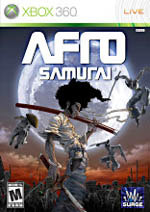 If Afro Samurai proved one thing, it proved that there's still a place for blood-spraying anime in North America. The gray-toned, five-part TV mini-series and its steady flow of gruesome swordplay also made for excellent game material. Granted, that game re-tells the events of the original show, with Samuel L. Jackson reprising the roles of Afro and his yammering sidekick (and internal conflict narrator) Ninja Ninja as they seek out a gunman named Justice. Along the way, they encounter murderous cultists, frequently naked women, and other sights and sounds that fill up the game's “M” rating box. The game pads that brief storyline with wider territory and far more opponents, ranging from grunting mid-bosses to a languid, gentlemanly blademaster (they may work in the wire-twirling assassin and halberd-wielding woman from the original Afro Samurai trailer that Takeshi Koike directed, but I suspect those two are lost to the ages). The developers have made much of the combat system, promising over 100 combos for Afro and a “focus” attack that lets him target and sever enemy limbs. It certainly captures the anime's muted colors, cinematic look, and RZA-composed soundtrack, even if there's already a glut of hyper-bloody brawlers on the market.
If Afro Samurai proved one thing, it proved that there's still a place for blood-spraying anime in North America. The gray-toned, five-part TV mini-series and its steady flow of gruesome swordplay also made for excellent game material. Granted, that game re-tells the events of the original show, with Samuel L. Jackson reprising the roles of Afro and his yammering sidekick (and internal conflict narrator) Ninja Ninja as they seek out a gunman named Justice. Along the way, they encounter murderous cultists, frequently naked women, and other sights and sounds that fill up the game's “M” rating box. The game pads that brief storyline with wider territory and far more opponents, ranging from grunting mid-bosses to a languid, gentlemanly blademaster (they may work in the wire-twirling assassin and halberd-wielding woman from the original Afro Samurai trailer that Takeshi Koike directed, but I suspect those two are lost to the ages). The developers have made much of the combat system, promising over 100 combos for Afro and a “focus” attack that lets him target and sever enemy limbs. It certainly captures the anime's muted colors, cinematic look, and RZA-composed soundtrack, even if there's already a glut of hyper-bloody brawlers on the market.